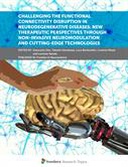Explore

Challenging the Functional Connectivity Disruption in Neurodegenerative Diseases: New Therapeutic Perspectives through Non-Invasive Neuromodulation and Cutting-Edge Technologies
0 Ungluers have
Faved this Work
Login to Fave
The neurorehabilitation field is increasingly focused on understanding how to efficiently revert the effects that acute (i.e., stroke or traumatic brain injury) or chronic (i.e., neurodegenerative diseases) insults play either on small or large-scale networks, encompassing motor, sensory and cognitive domains. The link between the disrupted neuronal pulse generators and their effectors is being re-shaped through a wide scenario that embraces biorobotics, robot-aided rehabilitation, non-invasive neurostimulation, nanoprosthetics and neuroengineering. For the past decade and at an amazing speed, large investments and efforts allowed enthusiastic and only apparently heterogeneous researchers to borrow theories from neurophysiology, pharmacology, physics and quantum mechanics in order to generate together highly sophisticated tools that restore, resemble or even substitute the basic biological architecture. The idea of actually reverting weakened functions and/or replacing the faulty parts either of the human body or the central and peripheral nervous system is becoming a new reality, opening a fascinating era in this field. In this Research Topic, several researchers showed how the above principles became reality, from theory to the bedside of patients, providing full explanations of the whole mechanistic processes and how they were implemented, up to the final stage.
This book is included in DOAB.
Why read this book? Have your say.
You must be logged in to comment.
